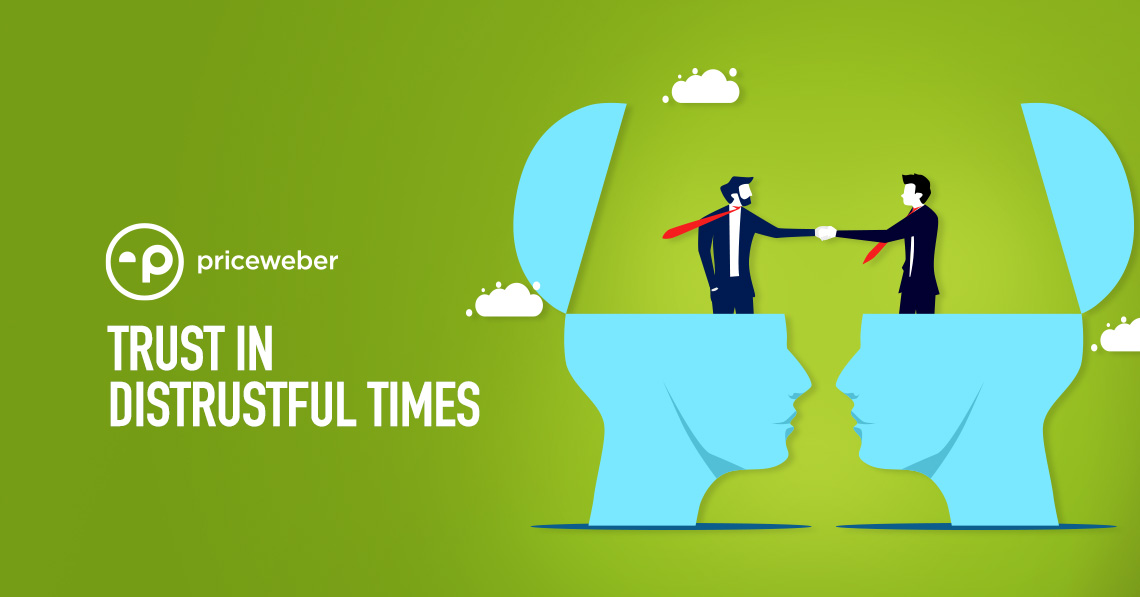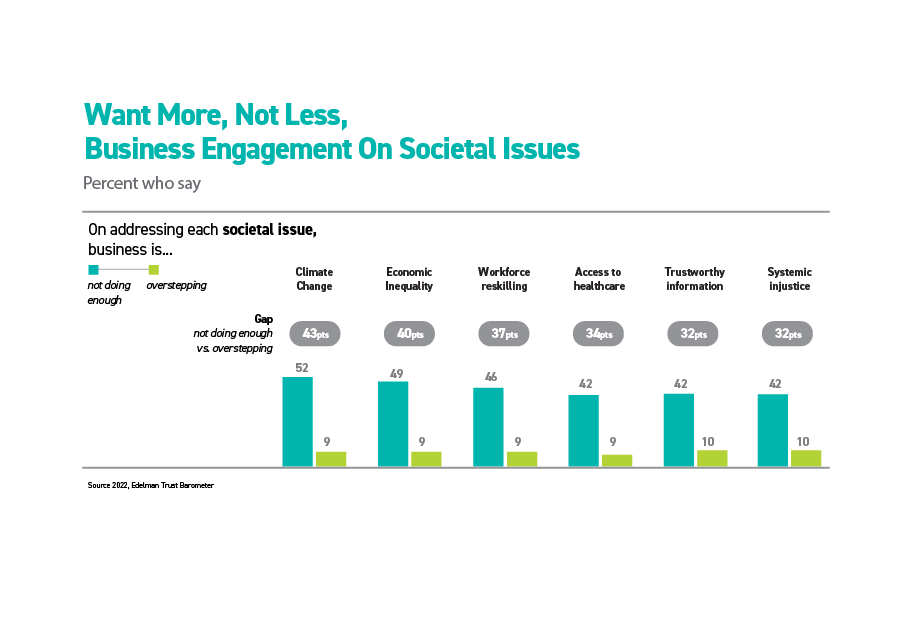You already know the importance of trust but are you thinking about this important form of capital the right way? In this edition of Plain Talk, we’ll explore brands looking at trust as something to be built rather than just simply something to protect.
For many years trust was viewed as something individuals or groups start out as having by default but can lose over time based on their actions. In other words, we have more to lose than to gain, right? While this seems rational, and thinking of it this way is comforting, it isn’t our current reality. In Edelman’s 2022 trust barometer study, the number one key finding was alarming: “Distrust is society’s default emotion.” Almost six out of 10 study respondents said they tend to distrust something until they see evidence that they should trust it.
Is Distrust on The Rise, And If So, Why?
It’s difficult to measure trust in a completely general sense, but there are several data sources that have measured trust in various types of organizations over time. For instance, the Pew Research Center has been a source for measuring trust in the U.S. government since the late 1950s. At the time of their latest release (in May of 2022), only 20% of Americans responded that they trust the government to do the right thing, at least most of the time. By comparison, that’s 14% worse than the 34% that trusted the government to do the right thing most of the time in 1974, right after Watergate. The last time that more than 30% trusted the government to do the right thing, at least most of the time, was in 2005.
The Edelman study measures trust across a broader spectrum with 28 countries represented and four categories of institutions (business, NGOs, government, and media). The Edelman study hasn’t been around as long (2001 was the first year of the study), but it, too, has shown a steady downward trend in trust, with 2022 being the first year of the 22-year study that showed distrust as society’s default rather than trust. In the Edelman study for 2022, businesses were the most trusted type of institution, with NGOs being second, government third, and media being last.
There are many likely causes for the shift from trust to distrust during the 21st century. Increases in fraud, “fake news” reports, and division in both politics and media reporting are all likely to have been contributing factors to the trend. Social behavior shifts, such as how people consume news and how and where social interactions take place – with much of this activity now being over social media platforms – are also likely causes for the shift. The COVID-19 global healthcare crisis also caused rises in fear and suspicion, which in turn may have fostered an increase in distrust of various institutions among many individuals, as well as a novel opportunity for scammers.
Is Trust Built, Given, Or Protected?
At PriceWeber, we talk about trust a lot. It’s one of the agency’s five core values. We also work with clients in several high-trust verticals, such as financial services, healthcare, and legal services. Whether we’re thinking about trust as it relates to our agency or thinking about building trust for the brands we work with, we work to keep in mind the multi-dimensional nature of trust.
Trust isn’t something you can just manufacture from within your walls – at least not when it comes to building trust with external audiences. Trust is a two-way street. In one lane is the person or group that’s building trust, and in the other are those that must give their trust. For this reason, the development of trust requires engagements between your organization and those whose trust you wish to earn. Brands must walk the right line of taking actions that earn trust while also engaging with audiences in a meaningful manner. When this is done correctly, it’s viewed as an ongoing relationship where the organization must protect and enhance the trust over time versus a finite transaction where trust is received, and then the organization moves on to other activities.
The idea that brands must take the initiative to build trust while patiently trusting that external audiences will reciprocate by giving it and then still be vigilant about protecting and even enhancing the trust relationship over time sounds like a lot of effort. Well, it is, but when we’re talking about arguably the single greatest asset an organization can possess, surely, we can agree that it should take more resources to acquire and maintain than the loose change under the break room sofa cushions.
What Can Brands Do to Build and Nurture Trust?
1) Having An Internal Culture of Trust Is a Must
Yes, building trust from external audiences means engaging with those audiences, but if you don’t have a culture of trust within your organization, then anything you do externally will seem hollow. The benefits of trust within an organization are both powerful and far-reaching. In his novel, The Speed of Trust, Stephen M. R. Covey said, “Trust is the glue of life. It’s the most essential ingredient in effective communication.” He viewed trust within a business or organization as not only something that can unite a group but something that can make it considerably more productive. In the absence of trust, behaviors such as micromanagement and suspicious speculation run rampant. With trust, entities can have significantly better culture and profitability. But how does this affect perspectives outside of your organization? Consumers care about how organizations treat their employees, and now more than ever, employees have a voice outside your organization. While social media catches a lot of blame for exacerbating distrust, it also gives employees a louder voice than they had before. The employees of an organization with a strong culture of trust can be powerful advocates for the brand, and this extends to past employees as well as the friends and families of employees that gain knowledge of how the organization treats people. Developing a reputation as a trustworthy company can help keep talent as well as acquire new talent and customers.
2) Stand Up for What Matters to The Brand
It’s understandable for brands and business leaders to exercise caution when it comes to addressing social issues. However, when framed correctly, taking a stance on issues or policies a brand believes in can be very beneficial. The below graphic from the 2022 Edelman study shows a large gap between respondents that said businesses aren’t doing enough when it comes to each issue listed below versus respondents that said businesses are overstepping. One important caveat to this, though, is that there’s a huge difference between having a loud voice when it comes to policies or issues and having a loud voice when it comes to politics. Brands should focus on the former by acting on what (policies/social issues/values) they believe in rather than who (political parties/politicians) they believe in. Aligning with non-profit organizations with shared values as the brand can be an effective way of influencing positive change without getting into politics as many non-profit organizations are viewed as trustworthy by individuals with diverse viewpoints. For more on the brand benefit of social responsibility, read this past article about ESG practices.
3) SEO And Online Reputation Management
It’s a funny paradox, but in an age when many say they don’t trust the news media or big businesses, they still trust what pulls up (news or not) when they submit a search query to Google. Authority has been a heavily discussed phrase in SEO circles for some time now, and with good reason. Establishing authority with Google is not only key to increasing impressions and traffic through organic search; there’s also pass along effect where many users who see your brand ranking highly for various phrases develop an association with your brand as being trustworthy and authoritative on the topics that it ranks highly for. Along with online authority, online reviews are another factor of SEO that has a multi-pronged effect. Positive Google Business reviews can have a large impact on a brand’s ranking with Google. The effect of strong ratings is also a powerful verification tool for the users who see them. With trust in the news media declining, the influence of online reviews is positioned to grow. How brands can improve their online reputation could be its own article, well actually, it already is – check out this article to learn more.
4) Public Relations
This might seem like a contradiction after showing data that trust in the news media is on the decline. However, trust in the news media declining, and it being important for brands to effectively leverage PR for building trust can both be true statements. If a particular group is prone to not trusting large national media outlets, that doesn’t mean they distrust local news affiliates. In fact, according to a Gallup/Knight Foundation poll, six in 10 Americans trust local news more than their national counterparts. Trade media is another avenue that is generally viewed as being credible and is often viewed as an advocate for a company’s respective industry. This means that knowing your audience and what they trust is more important than ever right now. This can be a great thing for mid-sized brands that can be strategic when it comes to PR because it means it isn’t just all about the size of your megaphone. Brands that frequently offer press access to top executives come off as being highly transparent. Quality online press is also very impactful when it comes to building authority with search engines making it highly difficult to have great SEO improvement without a strong PR strategy to back it up.
5) Be Consistent
Being consistent can mean a lot of things for a brand, but the first thing that comes to mind for most people in this context is consistency of branding. This is very important, but if you’re thinking about consistency only as it applies to your branding, then you’re thinking about it too narrowly. With fraud and online scams at an all-time high, and more fraud awareness education taking place, users are more suspicious than ever before of communications they receive. Everything from the channel the communication is received through and the sender’s information to the subject line, branding, copy formatting, and even communication cadence is scrutinized by recipients. Maintaining a stringent adherence to standardized communication practices is a must for brands that don’t want their customers to second guess. For absolute consistency, though, brands must look beyond only direct communications to customers. Everything from your website, building signage and letterhead to your social posts, sales presentations, and employer branding materials is an opportunity to exercise consistency
Trust In the Process
Despite the societal trend toward distrust, the Sophocles quote, “Trust dies but mistrust blossoms,” doesn’t have to be an absolute fate for all brands. There are many tools and tactics at your disposal that allow you to show the great values your organization upholds. There’s a good chance you’re already taking many of the actions needed to build and nourish trust but are in need of an overarching strategy along with some tweaks and optimizations. For help improving the trust of your brand, give us a call at (502) 499-4209, or contact us online!



